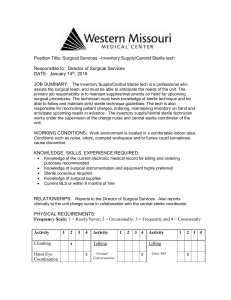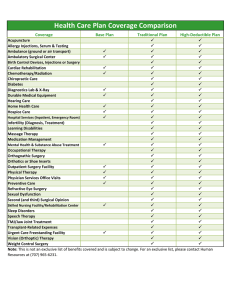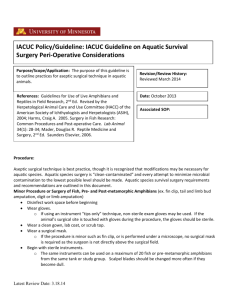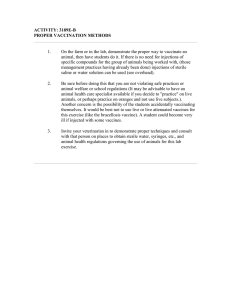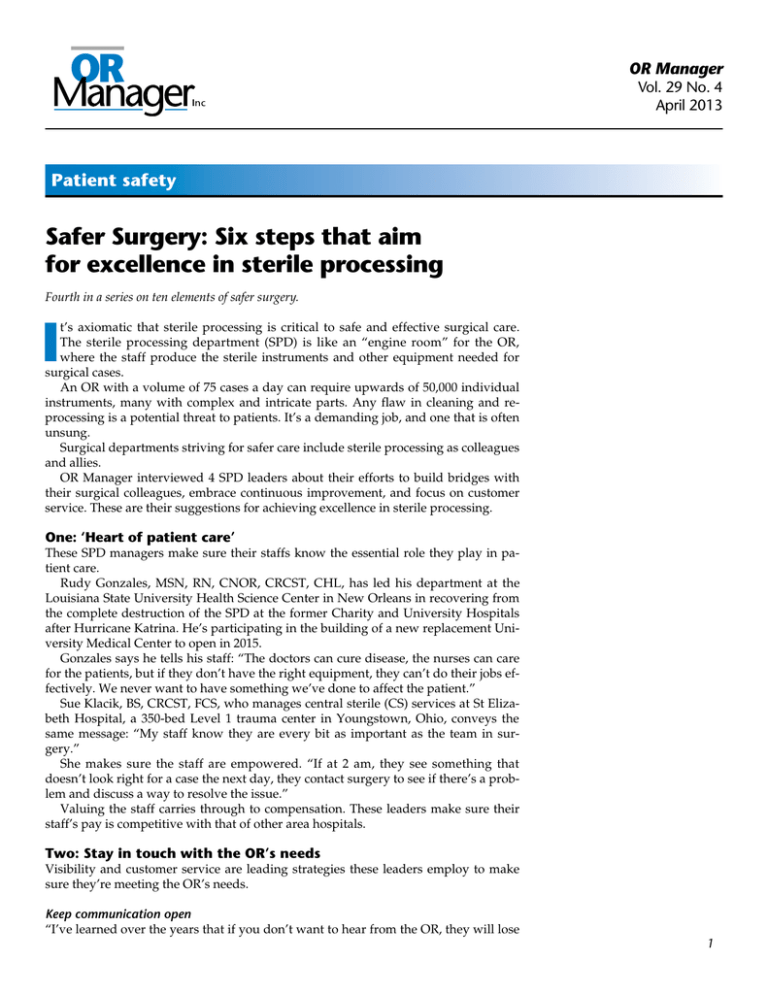
OR Manager
Vol. 29 No. 4
April 2013
Patient safety
Safer Surgery: Six steps that aim
for excellence in sterile processing
Fourth in a series on ten elements of safer surgery.
I
t’s axiomatic that sterile processing is critical to safe and effective surgical care.
The sterile processing department (SPD) is like an “engine room” for the OR,
where the staff produce the sterile instruments and other equipment needed for
surgical cases.
An OR with a volume of 75 cases a day can require upwards of 50,000 individual
instruments, many with complex and intricate parts. Any flaw in cleaning and reprocessing is a potential threat to patients. It’s a demanding job, and one that is often
unsung.
Surgical departments striving for safer care include sterile processing as colleagues
and allies.
OR Manager interviewed 4 SPD leaders about their efforts to build bridges with
their surgical colleagues, embrace continuous improvement, and focus on customer
service. These are their suggestions for achieving excellence in sterile processing.
One: ‘Heart of patient care’
These SPD managers make sure their staffs know the essential role they play in patient care.
Rudy Gonzales, MSN, RN, CNOR, CRCST, CHL, has led his department at the
Louisiana State University Health Science Center in New Orleans in recovering from
the complete destruction of the SPD at the former Charity and University Hospitals
after Hurricane Katrina. He’s participating in the building of a new replacement University Medical Center to open in 2015.
Gonzales says he tells his staff: “The doctors can cure disease, the nurses can care
for the patients, but if they don’t have the right equipment, they can’t do their jobs effectively. We never want to have something we’ve done to affect the patient.”
Sue Klacik, BS, CRCST, FCS, who manages central sterile (CS) services at St Elizabeth Hospital, a 350-bed Level 1 trauma center in Youngstown, Ohio, conveys the
same message: “My staff know they are every bit as important as the team in surgery.”
She makes sure the staff are empowered. “If at 2 am, they see something that
doesn’t look right for a case the next day, they contact surgery to see if there’s a problem and discuss a way to resolve the issue.”
Valuing the staff carries through to compensation. These leaders make sure their
staff’s pay is competitive with that of other area hospitals.
Two: Stay in touch with the OR’s needs
Visibility and customer service are leading strategies these leaders employ to make
sure they’re meeting the OR’s needs.
Keep communication open
“I’ve learned over the years that if you don’t want to hear from the OR, they will lose
1
OR Manager
Vol. 29 No. 4
April 2013
trust in you because you are not addressing the
issues,” says Mark Duro, CRCST, FCS, manager
of the Central Sterile Processing Department at
New England Baptist Hospital in Boston, a leading orthopedic center performing 25 to 30 joint
replacements a day.
When there is an issue in the OR, depending on how serious it is, Duro goes directly to
the room. Less critical issues are reported on a
communication sheet that records the date, time,
personnel involved, the issue, suggestions for
possible solutions, and a signature. Duro reviews
the sheets once a week and addresses the issues.
Safer Surgery series
This series of articles covers Ten Elements for Safer Surgery
developed by Advocate Health Care, a 10-hospital system in
the Chicago area.
Previous articles in the series focused on:
• OR governance: January 2013
• Safer surgical scheduling: February 2013
• Presurgical assessment: March 2013.
All-day seminar
An all-day seminar on the Ten Elements for Safer Surgery will be
presented at the OR Manager Conference September 23-25, 2013, at
the Gaylord National Resort in National Harbor, Maryland. For more
information, go to www.ormanagerconference.com.
Participate in daily huddles
Every day at 1:30 pm, Klacik or a CS coordinator
joins a huddle in the OR to review the next day’s
schedule and determine needs. At 3 pm, she
huddles with the CS staff.
“We talk about what’s happening tomorrow,” she says. “We discuss which trays
to watch for. If loaner trays aren’t in, we start calling the vendor.”
If necessary, she adjusts staffing to meet the requirements of the next day’s surgical schedule.
Round in the OR
Klacik and CS coordinators round in the surgery department throughout the day. “If
surgery has a question or comment, they can stop and tell us,” she says. “They know
we are accessible, and we can nip problems in the bud.”
Attend OR staff meetings
Duro attends OR staff meetings to share information. At one point, the OR was reporting holes in sterilization wrappers. An OR staff member asked, “Why not use
containers?” Duro had a chance to explain that many instrument sets have not been
validated by the device manufacturer for the use of sterilization containers.
“We have to follow the manufacturer’s instructions for use (IFU) for everything—
not just the equipment but also the packaging material,” he told them, noting that
failure to follow the IFU can incur liability.
Three: Educate, educate
Education of CS techs is the backbone of a safe, efficient sterile processing program,
Klacik emphasizes.
“I can’t stress how important education is in this job,” she says. With today’s demands, “techs need to be technically trained and to have critical-thinking skills.”
Klacik, an approved CRCST instructor, also serves as the educator for the department. “We teach the standards and recommended practices, along with the rationale
behind them,” she says. She also provides in-service education on all new equipment, including the IFU.
At St Elizabeth, certification of CS techs is a condition of employment. Klacik
teaches the classes herself. The hospital purchases the books, and education is conducted on work time.
2
OR Manager
Vol. 29 No. 4
April 2013
Four: Provide the right working
conditions
Klacik ensures the SPD staff have the proper
equipment and work environment to do their
jobs well.
“At our work stations, we have the correct conditions—the right lighting, equipment
like magnifying glasses, quality monitors, and
other tools,” she says.
IFUs are available on PCs throughout the
department, which provide access to onesourcedocs.com, an online database of manufacturers’ instructions.
At New England Baptist, sterile processing is
almost completely automated. In planning the
department, which opened 3 years ago, Duro
and his team scoured the US and Europe for the
latest in technology (related article, p 10).
Five: Support the staff and hold
them accountable
Ten components for safer surgery
The components of Advocate Health Care’s Safer Surgery initiative:
1. Perioperative governing body
2. Single path for surgical scheduling
3. Preanesthesia testing (PAT) with standardized protocols/
hospitalists
4. Document management system for scheduling and PAT
5. Excellence in sterile processing
6. Crew resource management
7. Implementation of a critical safeguards checklist
8. Daily huddle
9. Error reporting
10. Just culture
Accountability goes hand in hand with educa- Source: Advocate Health.
tion.
“If someone has made an error, we bring
it to their attention so the error doesn’t occur
again,” Klacik says. “They know what they do affects patient care, and they are
meticulous.”
Gonzales, who now has a master’s, relies on the bedrock values he learned in
the Army: “Make sure your staff have what they need to do the job, make sure
they’re trained, and make sure their pay is correct. Then most things will work
out.”
Six: Foster continuous improvement
At Virginia Mason Medical Center in Seattle, which has pioneered Lean management in health care, the director of sterile processing, Sam Luker, MBA, CRCST,
and his team have a constant focus on eliminating waste and mistake-proofing
sterile processing (related article, p 8). Every day begins with a daily “newspaper”
reporting on defects that reached the OR the previous day. Encouraged by a Japanese sensei, the department recently began working on a process to create just-intime instrument sets built to order for surgeons performing the next day’s cases. ❖
—Pat Patterson
Have a question
on the OR
revenue cycle?
Keith Siddel will respond to questions in the column. Send your questions to editor@ormanager.com
You can also reach Siddel at ksiddel@hrmlc.com.
Copyright
© 2013. Access Intelligence. All rights reserved. 888/707-5814. www.ormanager.com
3

